One way to learn valuable insights is to follow a free webinar. Mid October, I attended a webinar with the name “How to retire in 10 Years or Less?“.
 The webinar was led by JP Livingston and Grant Sabatier. Grant is the Author of Financial Freedom and Creator of MillennialMoney.com, which has reached over 10 million readers. He writes about personal finance, investing, entrepreneurship, and mindfulness and hosts the Financial Freedom podcast. J.P. Livingston is a former professional investor who retired at the age 28 with over $2.25 million. She writes about money, investing, and early retirement at The Money Habit. JP has been featured in CNN, Forbes, Business Insider, Marie Claire, Lifehacker, CNBC, and Cosmopolitan among other publications.
The webinar was led by JP Livingston and Grant Sabatier. Grant is the Author of Financial Freedom and Creator of MillennialMoney.com, which has reached over 10 million readers. He writes about personal finance, investing, entrepreneurship, and mindfulness and hosts the Financial Freedom podcast. J.P. Livingston is a former professional investor who retired at the age 28 with over $2.25 million. She writes about money, investing, and early retirement at The Money Habit. JP has been featured in CNN, Forbes, Business Insider, Marie Claire, Lifehacker, CNBC, and Cosmopolitan among other publications.
Below you can read our key learnings of this webinar and further on our perspective.
Our Key Learnings
The webinar starts with an explanation of the mindset of 90% of the population and what kids get taught at schools. The standard advice is that saving 10% of your income is “good”. The current personal savings rate in America is 2,7%. When you look at the table below, you notice that it will take you 51 years to retire at that savings rate.
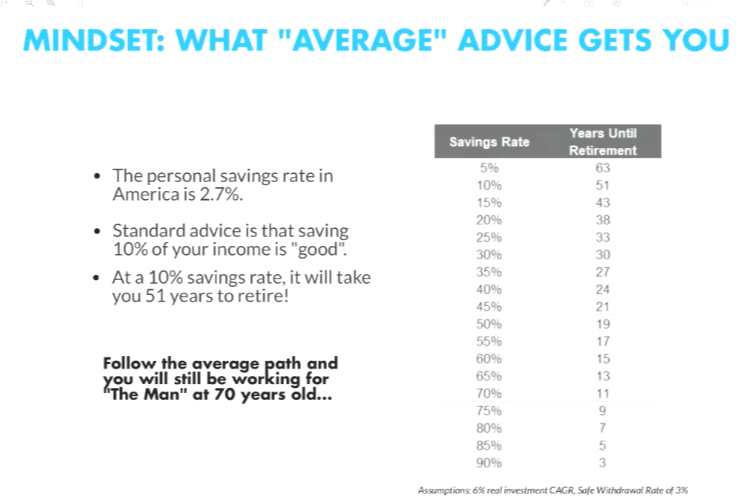
Grant and JP flip to an explanation of Early Retirement. What do you seek for in life ? Financial independence while doing the things you like, or do you prefer buying a big house, a big car,.. ? What makes you happy in life?
If your goal is to retire in 10 years or less, you need to focus on 4 categories : Earnings, Expenses, Investments and Taxes. You need to focus on two universal equations. Your income should be higher than your expenses so you can save money. Your savings should have a good growth rate after taxes so you build a nest egg.
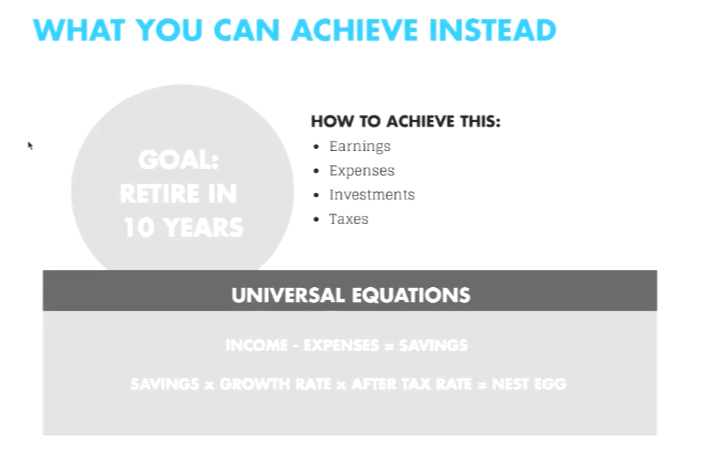
So the first principle to build wealth is to apply the principle of compound interest. Everybody should be familiar with this financial rule. If you have a side hustle of 1.000$ per month, you generate an extra income of 12.000$ a year. If you invest this with a growth rate of 7%, you generate a total of 491,945$ in 20 years.
So investing in a nest egg can throw you enough money to meet your annual needs. So how much money do you need ? With a safe withdrawal rate of 3-4% which equals to 45.000$ per year, you would need a 1,3 Million $. 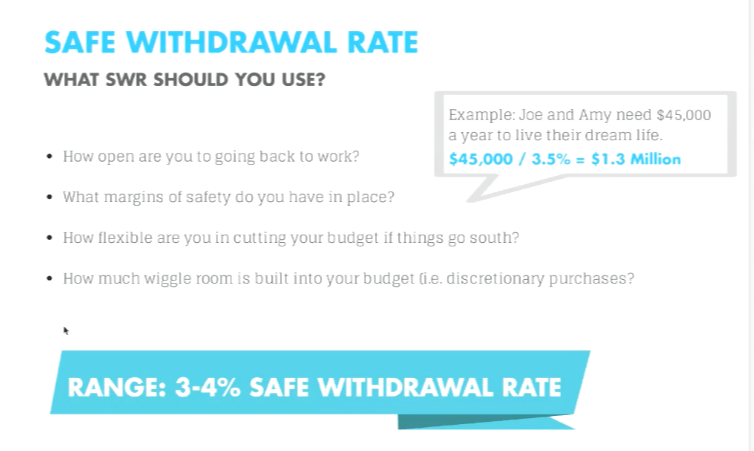
So that would be the goal. Let’s focus first on the Earnings.
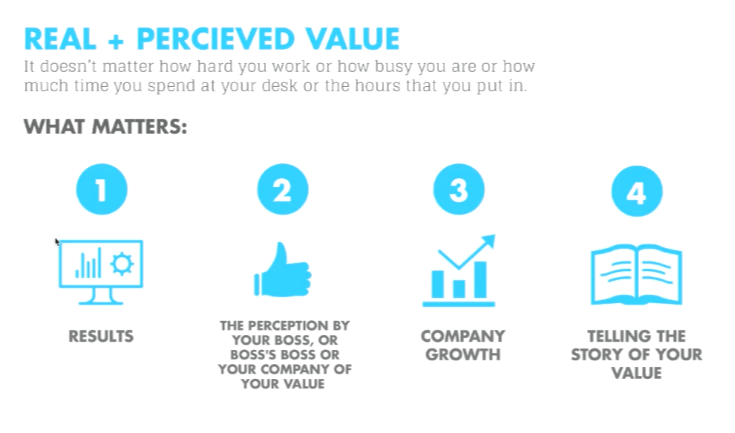
Earnings is all about how much income you (can) generate. But not only that… Grant talks about a management consultant performing many hours per week. How much net income does he really generate for all those hours of work? What really matters is 4 things :
- What are the results you achieve in relation to number of hours you perform? Work smart.
- What is the perception of your boss ? Are you entitled to ask for a raise? Don’t hesitate to change jobs if you want to earn more.
- Are you contributing the company growth? Are you entitled to an extra bonus? Don’t hesitate to ask.
- Marketeer yourself of your value and don’t be afraid to raise awareness of the value you create.
What else can you do to increase your earnings ? Side hustling. Grant walks us through different passive income studies such as a dog walking company, selling products on Amazon, and others which generate an extra yearly income. 4-6 hours a week equals 200-300 hours a year. Use them wisely and create that extra passive income.
The second category is savings. Here you can apply three different approaches. Read below. In approach 1 the three biggest categories are housing, car and food/entertainment expenses. Make sure you maximize your savings.
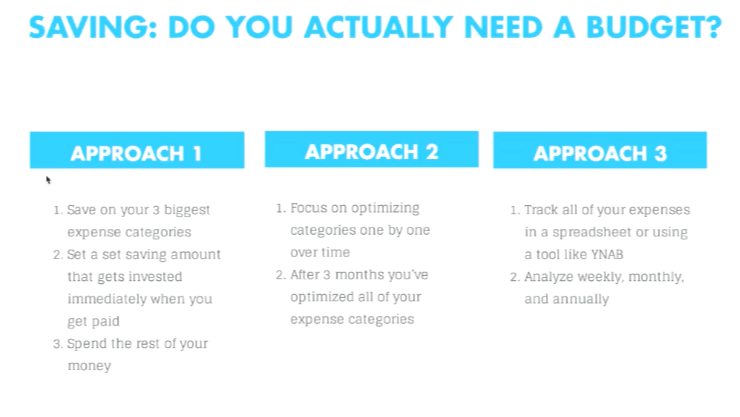 Category 3 : Investing. Investing is not complicated and not gambling. Good investing requires you to do two things:
Category 3 : Investing. Investing is not complicated and not gambling. Good investing requires you to do two things:
- Figure out what your goals are
- Find the best options to meet those goals
In investing strategies, there are four components important: Return, Risk, Timeframe and Cash flow. According to Grant and JP it is key to keep your investing strategy simple until you achieve $500.000 to invest. At that point it can be advantageous to develop a slightly more complicated investing strategy.

The key question is how many hours per month do you want to invest in your investments management? Below you see three different investment time allocations and how that matters for the final results. Basically three hours a month can double your net worth and earn you an extra $1 million.
If you want to invest your money, there are different investment strategies. According to Grant and JP there are three possible investor types. You can be a hands off investor, a research genius or a real estate mogul.
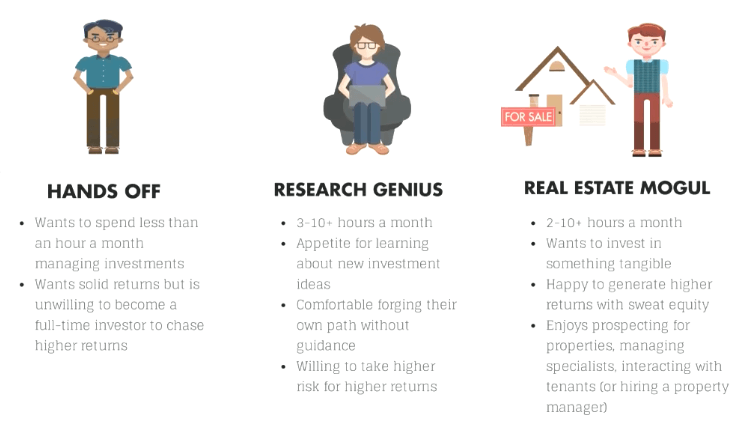
Below you find the case study of Drew who invested in 4 properties.

Before your retirement, the recommendation is to allocate 80% of your portfolio in index funds, 10% in individual stocks and 10% in bonds. Once you go in retirement, you can flip towards 40% rental real estate, 30% index funds and 30% bonds.
The last category is taxes. Here the key message is to minimize the taxes at ALL times.
So the summary is that there are four components to wealth. Tackle the first two components first and then focus on investment growth and tax efficiency to maximize ROI and value over time.
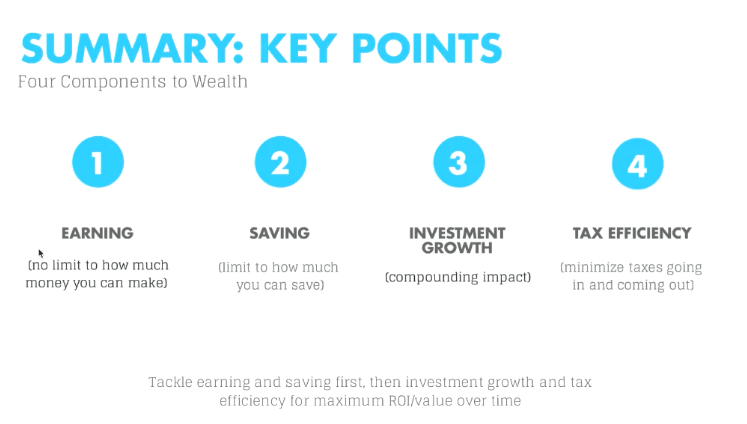
Our Perspective
This webinar where hundreds of people attended was a wise walkthrough on how you need to manage your money. According to me, there are three skills important. Those are:
- How to earn your money
- How to keep your money
- How to grow your money
 They correspond with the four components listed in this webinar. The only point where I disagree with Grant and JP is the investment strategies. I believe there are many more investment strategies available to grow your money and cash flow. Rental real estate gives you today in Belgium around 3% net return. That is hardly above inflation and without any problems with tenants or the property itself. Growing your money without allocating time to it, is impossible. In Belgium the majority of people is born with a brick in their stomach…lol. I know a lot of people who invest (only) in their own house. Is that a bad thing? No necessarily. My point is that most people don’t know how much money goes in the house maintenance bucket each year. This year they want a new garden, the next year a new terrace, the following year paint 2 rooms as makeover. People would be surprised how much money is invested in their house if you all add it up. Those investments do not necessarily increase the value of the house. I am convinced that if people would add up all their expenses from the past 20 years and subtract that from the sales price when they sell the house, that the cash flow total would possible be negative. Most people don’t keep track of those expenses and are only convinced that their house price always increases in sales price over time. Investing in their own house is the only thing the majority of people know. They are scared of the stock market due to media and/or government taxes. Only 35% of Belgians invest in the stock market while 264 million is parked on savings accounts.
They correspond with the four components listed in this webinar. The only point where I disagree with Grant and JP is the investment strategies. I believe there are many more investment strategies available to grow your money and cash flow. Rental real estate gives you today in Belgium around 3% net return. That is hardly above inflation and without any problems with tenants or the property itself. Growing your money without allocating time to it, is impossible. In Belgium the majority of people is born with a brick in their stomach…lol. I know a lot of people who invest (only) in their own house. Is that a bad thing? No necessarily. My point is that most people don’t know how much money goes in the house maintenance bucket each year. This year they want a new garden, the next year a new terrace, the following year paint 2 rooms as makeover. People would be surprised how much money is invested in their house if you all add it up. Those investments do not necessarily increase the value of the house. I am convinced that if people would add up all their expenses from the past 20 years and subtract that from the sales price when they sell the house, that the cash flow total would possible be negative. Most people don’t keep track of those expenses and are only convinced that their house price always increases in sales price over time. Investing in their own house is the only thing the majority of people know. They are scared of the stock market due to media and/or government taxes. Only 35% of Belgians invest in the stock market while 264 million is parked on savings accounts.
I personally believe there are many more ways to generate cash flow and grow your money. We are today focusing on dividend and options investing strategies. We are convinced that those two strategies can generate more cash flow going forward. Below you see a table of different investment strategies that I once received from a millionaire. I won’t explain each strategy in detail but you can clearly see the different results of each strategy.
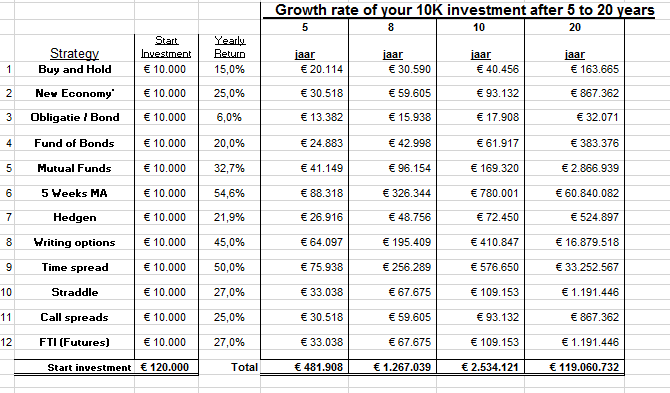
We are constantly exploring new investment strategies to grow our money. “Learn to grow your money” is the mission of the blog DividendCake. Stay tuned.
Final Words
So the key message of this webinar was to convince you to pursue early retirement by focusing on building wealth as quickly as possible. Here you need to focus on the four components as described above. Build as quickly the $500.000 dollars and then continue to grow your money so you can retire early. Today we don’t hit the 500k dollars net worth. Our focus is to grow our investing skills to grow our cash flow so we can invest in other cash flow generating assets.
If you want more information about this topic that Grant and JP discussed in their webinar, you can follow a detailed course for each of the four components at the following website “How to Retire in 10 Years or Less”
Are you working out investment strategies ? Don’t hesitate to leave your comments and feedback. Let us know what you think.
Good luck with your personal finance strategy! Thanks for following us on Twitter and Facebook and reading this blog post. As always we end with a quote.
Websites : https://millennialmoney.com/ ; https://www.themoneyhabit.org/


No Comment
You can post first response comment.